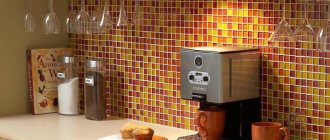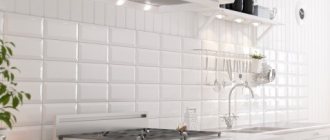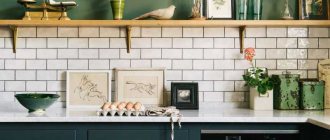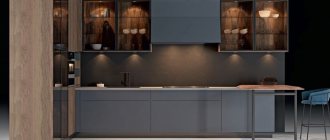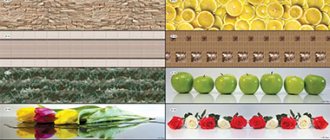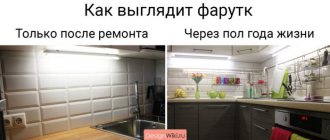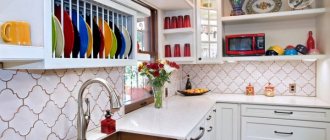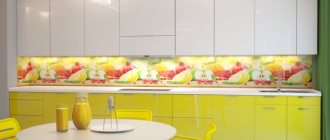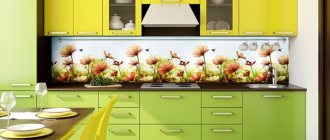The first thing that comes to mind when it comes to a kitchen backsplash is tiles. Yes, this finishing option has become so common that it is found in 95% of apartments in our country. But there is one alternative and very stylish solution - mosaic tiles for the kitchen backsplash. And even though the material is most often the same - glass or porcelain stoneware, it has its own characteristics for choosing the right one: shape, size and even color for a specific interior.
Many people think that mosaics are sold by weight in small squares. This is wrong. It is presented in stores in blanks most often 30 by 30 centimeters . The blank consists of a mesh onto which mosaic honeycombs are glued.
This grid, as the best assistant, allows you to lay the mosaic relatively quickly on the prepared wall: laying it in a small square would take a very long time. The presence of a grid-shaped base allows you to lay out the tiles yourself. How to do this is shown in the video.
Mosaic tile backsplash
Required tools:
- selected tile;
- tile adhesive and grout;
- putty knife;
- rag.
The question often arises about what to glue glass mosaics to, because they are most often transparent, and you wouldn’t want to spoil the look with ordinary glue. For such cases, a special white tile adhesive is useful - it will not spoil the overall picture.
Or you can look for self-adhesive tiles, but it is better not to use them in the kitchen, since this glue may not withstand changes in temperature and humidity.
Since the seams on the backsplash are a weak spot where bacteria collect, it is better to choose the most reliable grout. This is considered epoxy: it is not afraid of moisture and dirt, it is expensive, and only a professional can handle the application.
But if you don’t want to look at dirty seams two years after the renovation, it’s better to spend money. Moreover, mosaic tiles have a lot of seams, which means it will take a long time to clean them. Epoxy grout will allow you to do this less often, since it does not absorb dirt and water like a sponge.
The reason for the popularity of mosaics
Mosaic is a type of inlay that allows you to create amazingly beautiful images. Small multi-colored pieces of solid materials are arranged according to a pre-created sketch. There are two ways to perform a composition:
- direct set - mosaic elements are pressed into the ground;
- reverse set - the particles are placed face down on some kind of substrate, secured, the substrate is removed, and the seams are rubbed with adhesive.
To create mosaics, natural and artificial materials are used - glass, metal, enamel, pebbles, ceramics and others. When arranging the pieces, they lay out various patterns and drawings - thematic, folklore, geometric. People with creative abilities create real masterpieces of decorative art.
Laying mosaics on the wall is possible in any room with high humidity - in the bathroom, toilet.
Mosaic inserts look good in the kitchen interior Source pinimg.com
The pattern does not change color and does not deteriorate under the influence of steam or high temperature. Mosaic is easy to care for - the surface can be easily cleaned with a damp cloth and detergents. Mosaic finishing retains its original appearance for a long time, but when installed correctly.
Let's figure out how to put a mosaic on the wall so that it pleases the owners for many years.
Manually laying out patterns with small stones and glass takes a long time. To facilitate cladding, tesserae were created - square matrices with mosaic elements fixed on a grid. Mosaic tiles vary depending on the material:
- ceramic - have the same properties as tiles. It is characterized by high wear resistance, moisture resistance, strength, heat resistance, and ease of maintenance. May have a matte or glazed surface;
- glass - spectacular, but requiring careful selection of glue so that it does not shine through the material. They require complex care, as they are not resistant to aggressive environments and do not tolerate cleaning with abrasive agents;
Glass mosaic Source stroipark.com
- metal - made of aluminum or stainless steel. Mosaic looks unusual and is used to create exclusive interiors. Difficult to maintain and install;
- made of natural stone - expensive, allows you to create a luxurious design. Installation is carried out using ordinary glue or cement-sand mortar.
See also: Catalog of companies that specialize in finishing materials and related work
Interesting options in interior design
The interior of a classic white kitchen can be complemented with an apron in bright colors. A decorative element can combine the colors of furniture, lamps, dishes, and textiles. It is possible to create an artistic image from glass or mother-of-pearl, which will become a bright accent of the interior.
For a retro-style room, a kitchen apron made from ceramic elements in natural shades with scuffed effects and custom-made finishes is optimal.
For a kitchen in the Provence style or with an Italian design, the apron should be made in the same color scheme as the decoration of the room, furniture, and textile decor. It is optimal to use ceramic mosaics with glazing or mother-of-pearl elements, which will visually expand the room. Mosaic will emphasize the elegance of style solutions.
Kitchens decorated in high-tech style are complemented by an apron decorated with metal elements. A mosaic of silver, gold, bronze shades can be used.
The decor of the apron should match the tone of the fittings, hoods, and household appliances.
The decoration of the kitchen area can be the central piece in the room.
An effective and practical design option for a kitchen apron in a modern interior is a selection of glass mosaics in brown tones (chocolate, sand, milk, mustard). The warm shimmer of small decorative elements will highlight functional modular furniture.
It is recommended to complement the interior with spotlights in the kitchen work area.
Subtleties of laying mosaics
Let's take a closer look at how to glue a mosaic on a wall. First of all, you need to prepare tools and materials:
- knife;
- grinder;
- glue;
- pencil;
- electric drill;
- bucket;
- grout;
- putty knife;
- mosaic tiles.
Laying includes the following steps:
- cleaning, priming, sanding, drying walls;
- surface marking - mark the layout of the tiles with a pencil;
- applying the adhesive composition to the wall and sheets with a spatula;
- mosaic installation - the tile is pressed to the surface with glue and pressed with a roller or spatula;
- removing the backing - run a wet sponge over the surface and remove the paper backing diagonally, pulling at the corner;
Removing the backing Source dizainvfoto.ru
- moisturizing and grouting;
- cleaning the tiles diagonally with a damp sponge;
- polishing with a dry cloth.
Preparing the walls
The main secret of high-quality mosaic cladding is perfectly smooth walls. The plane must be flat, without differences horizontally or vertically. The best way to achieve smooth walls is to plaster them along the beacons.
I will talk about plaster briefly, since this topic deserves a separate article.
- The walls are cleaned of old finishing and plaster. We remove all layers that do not adhere well.
- If the wall is too smooth, use an ax to make notches to increase adhesion.
- We prime the walls and install beacons. First, the outer beacons are installed. They are attached to the wall using gypsum plaster and are leveled in one plane. Then threads are stretched between them and intermediate beacons are placed. The step between them should be less than the width of the rule, that is, for a 2-meter rule we take a step of 1.5-1.8 m.
The beacons are installed level in the same plane. Notches on the wall to improve adhesion.
We apply plaster and wait until the walls dry. It is advisable to use cement plaster for tiles and mosaics, but gypsum plaster (Rotband) is also suitable for the kitchen.
Glue
Many people are interested in what to glue the mosaic onto so that it holds firmly. The adhesive composition must be carefully selected to match the properties of the wall surface, material, and operating conditions.
Special tile adhesive
The easiest way is to purchase a special adhesive for tiles at a building materials store, made on the basis of Portland cement with the addition of plasticizers. This is a ready-made composition that only requires dilution with water to the required thickness. The glue ensures reliable adhesion to any surface. This glue is not suitable for glass mosaics due to its light gray tint.
Tile adhesive Source purplemint.ru
Polymer glue
The acrylic-based mixture ensures reliable fixation of mosaics made of any materials on various surfaces. This is the best ready-made adhesive for rooms with humid air. Dyes are added to the composition, which makes it possible to use it to create interesting design solutions. Before use, stir and apply to the surface. The glue dries quickly, forming a glass-like mass.
Size and consumption
The most common form of mosaic blank is square . Usually its side is 30 or 32 centimeters. There are also larger options: for example, with a side of one meter. Most often, some kind of drawing is already depicted there. Of course, such a panel will be expensive. In addition, the workpiece (matrix) can be round, rectangular or any other irregular shape.
Inside the matrix there are pieces of tiles - they are called chips or honeycombs . A standard chip is a square with a side of 2 or 5 centimeters. But there are also extreme versions of chips: for example, with a side of 1 or 10 centimeters.
How to determine consumption?
Even a renovation novice can cope with such a simple task. Here are the step-by-step instructions:
- Measure the length and width of the proposed apron.
- Decide on a mosaic and find out its dimensions.
- Calculate how many whole matrices will fit along the length and height of the apron.
- Calculate how many centimeters remain free and how many matrices are required for this.
Let's say the selected matrix is a square with a side of 30 centimeters. The apron size is 60 cm in height and 130 in length. The height is exactly two rows of mosaic (60/30=2). The length is 4 complete matrices (130/30=4.33). These 4 matrices will cover only 120 centimeters, which means there are still 10 left. It is important to multiply these 10 centimeters by the number nearby. As a result, there are 20 free centimeters, for which one workpiece is enough. And we multiply the resulting 4 by two rows - 8 matrices.
Thus, for an apron 130 by 60 cm, you will need 9 mosaic blanks measuring 30 by 30.
But it is advisable to always take tiles with a margin of 10–15% , since sometimes defects occur and there are errors in calculations. Or in a few years the mosaic will be damaged and will have to be replaced - in this case, a pre-purchased “spare” will save you. If there are doubts about the accuracy of the calculations, consultants in the store can always double-check the data received.
Nuances
Each type of mosaic tile requires compliance with certain gluing rules.
Let's look at how to glue mosaics on a grid.
The sheet is held with the front side facing you, and the back side is immersed in the adhesive Source colibrimosaic.ru
Gently press it against the wall with a roller or spatula so that the distance between the mosaic squares is the same. Remove any remaining glue and wait until it dries completely.
TOP manufacturers
- Axton mosaic adhesive. It is used for interior decoration with mosaics in bathrooms, showers, and kitchens. Axton glue is available in the form of a dry mixture for mixing. Has high adhesion to concrete, brick and plaster.
The diluted mixture is viable for 2 hours. Economical consumption, allows you to apply glue in a layer of up to 5 mm. Axton provides reliable fastening without loosening or falling out of mosaic chips.
Recommendations
Knowing how to lay a mosaic correctly, listen to the advice of experienced craftsmen:
- do not press the sheets against the wall with your hands to avoid unevenness;
- to prevent the glue from drying out, the surface area should be no more than nine tiles;
- dilute the glue to a medium consistency, since a thick composition dries quickly, and a liquid one sticks;
- carry out installation at a temperature not exceeding +25 degrees;
- Apply mosaic adhesive on the mesh in a layer of no more than 3 mm, so that excess solution does not complicate the grouting.
Recommendations will help you avoid mistakes.
Mosaic masonry looks both solid and in combination with other materials. Source keram-market.ru
How to use it correctly
Before starting work, cement mixtures must be mixed with a solvent, and in reactive compositions, the base and hardener must be combined. Dispersive ones do not need to be stirred.
The rules of use are the same for almost all adhesives:
- Mix small portions - this is what the masters recommend. Reactive and cement mixtures quickly thicken and become difficult to work with. The density prevents the mass from being evenly distributed, so the decorative elements are laid unevenly.
- Apply the glue to a small area of the wall in a thin layer. After gluing the decorative elements, the adhesive mixture is applied further. Coating large surfaces causes the adhesive to begin to polymerize before the tile is attached. This reduces the quality of adhesion.
- Most cement mixtures are produced in packages of 25 and 5 kg. If you plan to decorate large areas, it is cheaper to buy in large packs.
Briefly about the main thing
Mosaic tiles allow you to quickly and inexpensively tile the surface of any room. The variety of types makes it possible to choose the best option for different wall surfaces.
The basic requirements for creating a beautiful and durable mosaic are knowledge of what material the tiles are suitable for the room, and what glue to use to glue the mosaic.
Mosaic allows you to implement any design idea at low cost. The cladding looks impressive, and its properties are not inferior to ceramic tiles.
After studying the instructions on how to lay mosaic tiles, you can decorate a bathroom, toilet or other room yourself. It is important to adhere to the rules and recommendations for laying mosaic tiles.
Ratings 0
Advice from the experts
Various compounds are suitable for gluing, including liquid nails or hot melt adhesive. Before laying the mosaic, experts advise assessing the following parameters:
- Materials for gluing. The nature of the base and decor is taken into account.
- Place of work. Mixtures are selected taking into account humidity and temperature exposure.
- Color. White is only needed when gluing transparent parts. In other cases, color does not matter.
- Evenness. Pre-leveling the base will reduce consumption per m2 and improve adhesion.
These recommendations will reduce costs without compromising the quality of finishing work.
The choice of glue determines how firmly the mosaic will hold and whether it will change color. By following the recommendations of the experts, you will be able to select a composition that ensures good adhesion and avoid unnecessary costs.
